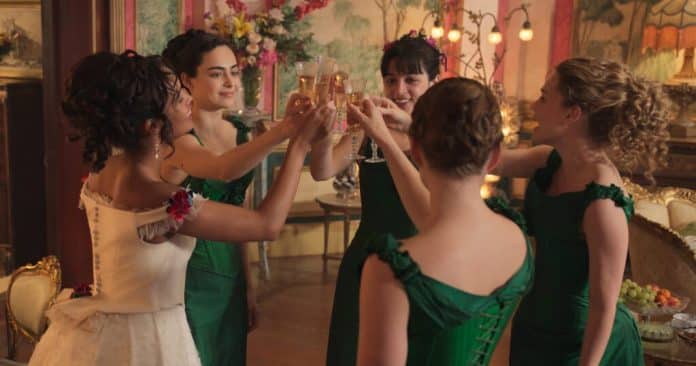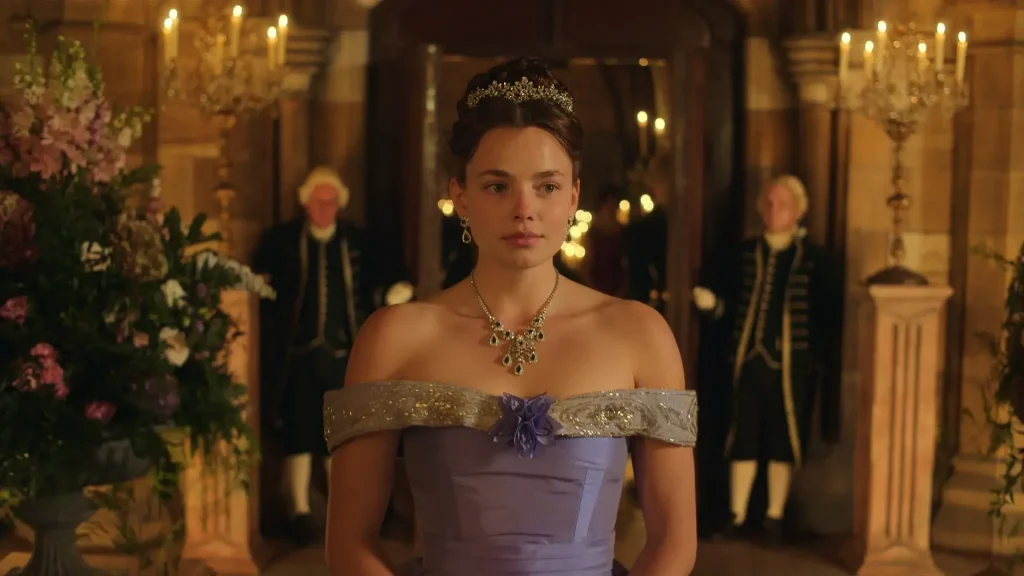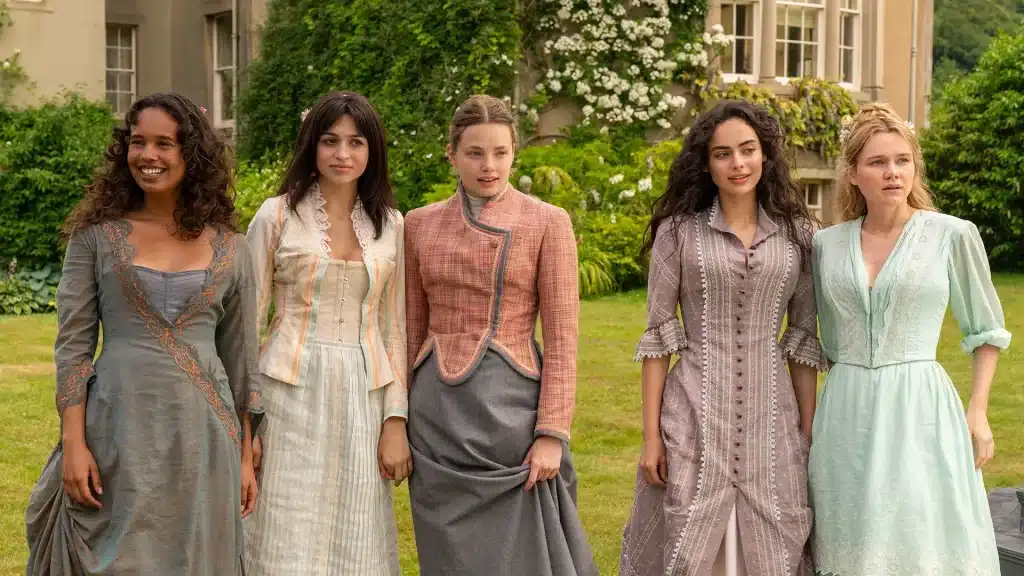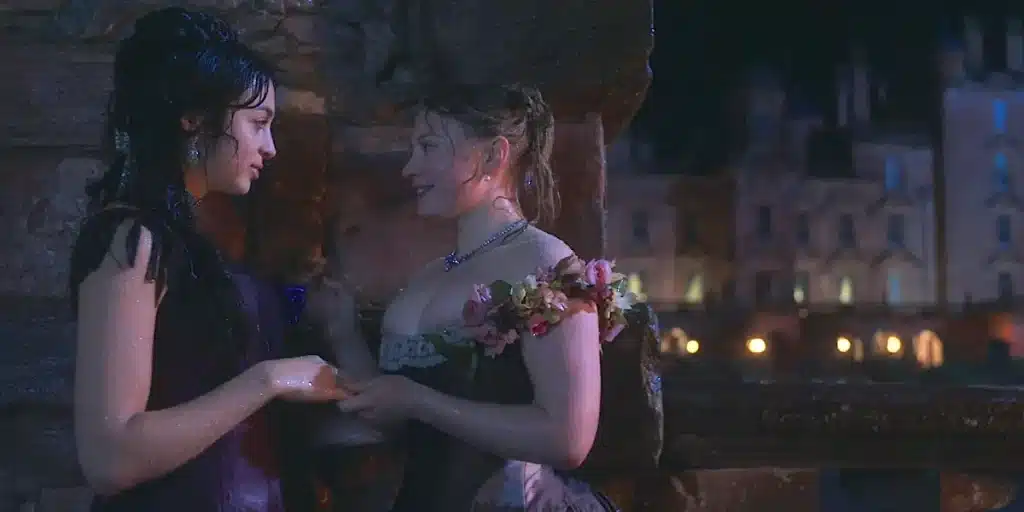Is The Buccaneers a True Story? – Hey there, fellow binge-watchers! Have you ever found yourself caught up in the charm of period dramas, where corsets are tight and societal norms are even tighter? Well, Apple TV+ has something special for you – “The Buccaneers.” But wait, is this riveting series based on a true story, or is it just a captivating work of fiction? Let’s dive into the historical tapestry and unravel the truth behind “The Buccaneers.”
Airing on Apple TV+, this period drama created by Katherine Jakeways takes us back to the 1870s, where five American heiresses embark on a quest for love and titles in the heart of London’s high society. With stars like Simone Kirby, Kristine Froseth, Guy Remmers, and Matthew Broome gracing our screens, the show promises a delightful mix of drama, tension, and a glimpse into the challenges of adjusting to high society.
The Buccaneers Plot Story
A group of five American friends, titled, “The Buccaneers,” making their way to London during the Gilded Age. Meet Virginia “Jinny” St. George, Annabel “Nan” St. George, Elizabeth “Lizzy” Elmsworth, Mabel Elmsworth, and Conchita Closson. Their mission? To secure themselves an aristocratic match, navigating the complexities of societal expectations and the pursuit of happiness.
Inspired by Edith Wharton’s unfinished novel of the same name, the series delves into the exciting events of the 1870s, where new money American girls sought to elevate their social status by marrying British aristocrats. The plot unfolds against the backdrop of a historical phenomenon – the influx of “dollar princesses” into British high society during the late 19th and early 20th centuries.
Is The Buccaneers a True Story?
Now, let’s get to the burning question – is “The Buccaneers” based on a true story? Well, The Buccaneers is not based on any one true story, but the series and its source material share deep connections with a fascinating chapter in history. The term “dollar princesses” wasn’t just a catchy phrase; it was a real-life trend. In the Gilded Age, as America reveled in economic growth, British aristocrats, struggling with financial woes, found themselves in need of a financial boost. Enter the American heiresses, armed with substantial dowries, eager to exchange their wealth for coveted titles.
The phenomenon wasn’t just a fleeting trend. Approximately 454 American heiresses married English aristocrats between the late 19th century and the early 20th century. These unions injected an estimated $25 billion into the bank accounts of British aristocrats, saving many estates from financial ruin. Imagine it as a financial transaction with a side of love and societal status.
The series, while fictional in its characters and plotlines, draws inspiration from this historical trend, shedding light on the lives of these women who, driven by ambition, ventured across the Atlantic in pursuit of love and status. It’s a nod to the Gilded Age, a period marked by glittering surfaces concealing underlying greed and corruption, as eloquently coined by Mark Twain.
Unveiling the True Story
But who were these dollar princesses in real life? Think about it – Jennie Jerome, daughter of a New York financier, marrying Lord Randolph Spencer-Churchill in 1874, eventually becoming the mother of Winston Churchill. This wasn’t just a storyline; it was history in the making. Even Princess Diana had a connection to this phenomenon, being the great-granddaughter of one such “dollar princess,” Frances Ellen Work.
Now, this isn’t a fairy tale with a guaranteed happy ending. The reality for many dollar princesses was far from glamorous. Picture this – marrying into a world where modern conveniences were scarce, adapting to a society that initially snubbed them, and entering marriages that were often more financial agreements than unions of love.
Take Consuelo Vanderbilt, for instance, who married the Duke of Marlborough in 1895. Hers was a loveless marriage, and the lack of modern comforts added to her woes. Many dollar princesses faced similar challenges, dispelling the romanticized notions of their lives. While the TV series may add its dramatic flair, the core inspiration comes from the grit and determination of these women who defied societal norms for a chance at a different kind of happily ever after.
Exploring the Historical Influences
As we immerse ourselves in “The Buccaneers,” it’s worth exploring the real historical influences that shaped this era. The Gilded Age, a term coined by Mark Twain, captured the essence of a period glittering on the surface while harboring economic disparities and social upheaval underneath. While America soared with economic growth and increased wages, Britain faced economic setbacks, especially among the aristocracy.
Enter the dollar princesses – young American women with substantial wealth but shunned by elite American society. The solution? Marry into British aristocracy. This exchange of wealth for titles became a trend, with matchmaking services, personal ads, and the allure of titles circulating among eligible bachelors and bachelorettes on both sides of the Atlantic.
As we enjoy the fictionalized drama of “The Buccaneers,” it’s fascinating to note how these events influenced not only the lives of the individuals involved but also the trajectory of two nations. The cultural exchange, the financial injections into the British economy, and the establishment of connections that spanned generations – it’s a slice of history that goes beyond the confines of the TV screen.
The Buccaneers: A Modern Take on History
Katherine Jakeways, the creative mind behind the series, brings a modern take to Wharton’s historical narrative. The characters are fully formed, breathing life into a world that combines traditional period drama elements with a fresh perspective. The all-female creative team expands on the book’s characters, diversifies the cast, and introduces storylines that add layers to the narrative.
In the spirit of modern storytelling, “The Buccaneers” isn’t just about romantic entanglements and societal expectations. It’s a celebration of female friendships, showcasing the strength and resilience of the central characters. The girls may navigate conflicts, make mistakes, and experience jealousies, but at the core, their bond remains unbreakable.
And let’s not forget the soundtrack – an ultracontemporary selection featuring all-female artists. From Warpaint to Gracie Abrams, the music adds a unique flavor to the series. It’s a nod to the present while immersing us in the past, creating a viewing experience that bridges the gap between centuries.
Conclusion: Behind the Glamour, a Tapestry of History
As we indulge in the glamour and drama of “The Buccaneers,” let’s appreciate the tapestry of history woven into its narrative. While the characters and events may be fictionalized, they draw from a real phenomenon that shaped the destinies of many. The dollar princesses weren’t just figures in a bygone era; they were trailblazers who dared to redefine their narratives.
So, is “The Buccaneers” based on a true story? The answer lies in the historical echoes that resonate throughout the series. It’s a captivating blend of fact and fiction, offering us a glimpse into a time when love, wealth, and societal status hung in delicate balance. As we embark on this historical journey through our screens, let’s toast to the dollar princesses who left an indelible mark on the pages of history.
Unravel the Intriguing Story of ‘The Buccaneers’ with Each Episode
Now that we’ve scratched the surface of the historical inspirations behind “The Buccaneers,” each episode promises to unravel more layers of drama, romance, and societal intricacies. Whether you’re a fan of period dramas or simply enjoy a riveting tale, this Apple TV+ series invites you to step into the opulent world of the Gilded Age.
From the glittering ballrooms of London to the intimate moments shared among friends, “The Buccaneers” captures the essence of a bygone era. So, buckle up for a journey through time, where love knows no societal boundaries, and the pursuit of happiness takes center stage. Each character, with their unique quirks and aspirations, adds to the richness of the narrative.
Q: Are the characters in ‘The Buccaneers’ based on real people?
Absolutely! While the series is a fictionalized account, it draws inspiration from the lives of American heiresses who ventured across the Atlantic to marry British aristocrats during the Gilded Age. Think of it as a historical remix, blending real-life events with creative storytelling to bring you an immersive viewing experience.
Q: Did dollar princesses really exist, or is it just a plot device?
No fiction here – dollar princesses were a real phenomenon. These were American women with significant wealth who married British aristocrats, injecting substantial funds into the struggling British aristocracy. “The Buccaneers” takes this historical backdrop and weaves a tale of ambition, love, and societal expectations.
Q: How accurate is the portrayal of dollar princesses’ lives in the series?
While the series adds its dramatic flair, the core challenges faced by dollar princesses were real. Marrying into a world with fewer modern comforts, adapting to a society that initially rejected them, and entering marriages often driven by financial agreements rather than love – these were struggles mirrored in the lives of many real dollar princesses.
Q: Did the dollar princess phenomenon really save British estates from ruin?
Absolutely! The influx of American wealth through these marriages provided a financial lifeline to many struggling British aristocrats. It’s not just a plot point in the series; it’s a historical fact that played a crucial role in preserving the grandeur of numerous estates during a time of economic decline.
Must Read: The Buccaneers Episode 5 Recap and Ending Explained















